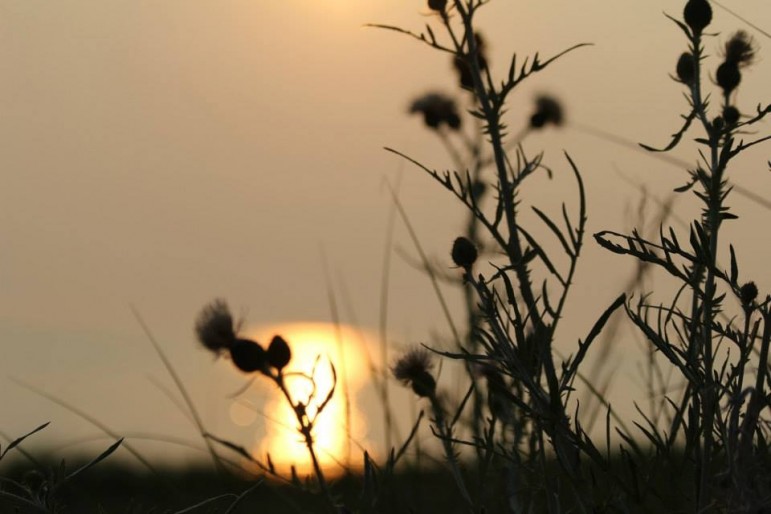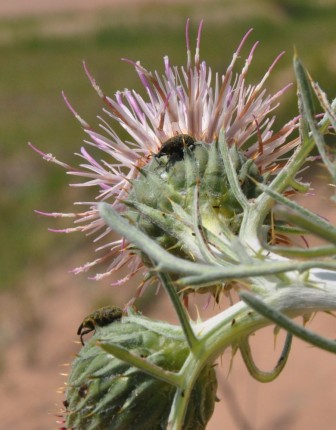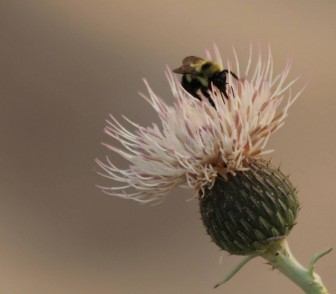
Image: U.S. Fish & Wildlife Service, Vince Cavalieri
By Ali Pechu
Invasive plants are further harming the fate of the already-threatened Pitcher’s thistle, according to a new study.
And weevils brought in to control other weedy thistles are yet another new threat to the Pitcher’s thistle that grows on Great Lakes sand dunes, according to the study supported by the U.S. Fish and Wildlife Service, the Michigan Department of Natural Resources, the Great Lakes Restoration Initiative and the University of Michigan Biological Station.
Their report suggests that seedlings from greenhouses are needed to preserve the plant that was federally listed as threatened in 1988.
The study modeled the impact of invasive plants on the sandy shores of lakes Michigan, Huron and Superior where the Pitcher’s thistle grows.
Claudia Jolls, one of the authors of the study, said it shows new challenges for a plant already threatened by shoreline development. “Shade and accumulated leaf litter on the ground from invasive plants is the new threat,” she said.
These invasive species dominate landscapes and are more abundant than the naturally occurring dune species.
“We do not know the exact mechanism of how Pitcher’s thistle seedlings are harmed by leaf litter,” Joll said. “Other studies, including some of our publications, suggest that light is required for germination and seedling establishment. Litter can act as shade, also.”
Two notable invasive species of most concern are baby’s breath – the flower commonly used in rose bouquets – and the spotted knapweed.
“While these species have been a concern for a couple of decades, newer management focuses on physical removal and limited use of chemical herbicides on the dune landscape,” Jolls said.
The Michigan DNR at Wilderness State Park has found that pulling spotted knapweed by hand has been particularly effective at controlling the plant. It is often done before the weeds become overwhelming, said Dan Kennedy, the endangered

Weevil on Pitcher’s thistle. Image: Chicago Botanic Garden
species coordinator at the state agency.
That’s on top of already well-known problems for the plant that are caused by shoreline construction and recreation.
Another new threat to Pitcher’s thistles is the weevils that were introduced in North
America to control other weedy thistle species.
“A major concern is that Pitcher’s thistle reproduces only by seed,” Jolls said. “These plants live for a long time, flower only once, and their survival depends on the success of the seed.”
Some weevils are seed predators and threaten the success of Pitcher’s thistle reproduction, she said.
The U.S. Fish and Wildlife Service has confirmed that the weevil harms the Pitcher’s thistle, although researchers don’t yet know the extent of the harm.
“They are either from Europe or Asia, that have either come here accidentally or purposely released in parts of the U.S. that prey on the Pitcher’s thistle seeds,” said Vince Cavalieri, who is leading Pitcher’s thistle research and conservation efforts for the federal agency. “And these weevils have been detected on the plant in Michigan.
“Right now many people are working to look at that threat and see how much of a problem it might be for that plant,” he said.
Doing so is important before considering delisting the plant as threatened.
Pitcher’s thistle is an important plant in the dune ecosystem. More than 30 species of insects, mainly bees, have been observed pollinating the plant. The seeds are also a source of food for small mammals such as the ground squirrel.

Image: U.S. Fish & Wildlife Service, Vince Cavalieri
Pitcher’s thistle grows well in disturbed habitats, particularly open dunes with lots of shifting sand, like dune blowouts where few other plants can grow. They do not fare well when the dunes are stabilized against erosion or when vegetation shades them out or builds up dead leaves on the ground.
“This means that to protect Pitcher’s thistle, we need to prevent dune stabilization as much as possible,” Cavalieri said.